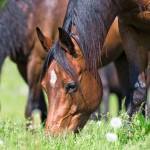Lush Grass: Good or Bad?

Horse owners and farm managers frequently use the word “lush” to describe the state of pasture forage as it begins to grow rapidly in the spring. What does “lush” mean exactly? Is this new grass good for horses, or dangerous for them to graze?
In defining “lush,” the dictionary uses words like “growing vigorously; lavishly productive; thriving; plentiful; delicious; savory.” Lush pasture, then, is a grazing area with plenty of abundant green forage that tempts horses to graze enthusiastically for hours on end.
Lush spring grass, mature summer grass, and dried autumn grass contain the same basic ingredients—water, vitamins, minerals, protein, sugars, starch, and structural fiber among other things—but the proportions of these ingredients are far different depending on season. Spring grass grows rapidly, containing a large proportion of water, up to 80% or more. This grass is generally soft and easy to chew because the amount of indigestible fiber is low, much less than in mature grass.
Because there is so much liquid in new spring grass, all the other components are found in lower proportions compared to mature grass, so the horse gets less sugar per mouthful of grass than when grazing in the summer. However, because this soft grass is so palatable, horses tend to ingest a larger volume of forage, so their dry matter intake of all nutrients may actually be fairly similar in spring, summer, and early fall.
Fructans are specially adapted storage forms of sugars that are found in cool-season forages. Fructans and other sugars are produced by photosynthesis that occurs in the leaves during daylight hours. During the dark phase of photosynthesis, which occurs at night, plants use the sugars to grow more leaves and stems. When more sugar is made than used for growth they are stored within the plant tissues, like the root, leaf sheath, leaf base, and leaf blade.
Many cool-season grasses store more fructans in the base of the plant than in the leaves. Perennial ryegrass has the capacity to store the higher concentrations of fructans than other cool-season grasses like fescue, orchardgrass, and timothy. The amount of fructan present in a cool-season grass is in a constant state of flux with factors of the species of grass, stage of growth, amount of sunlight, temperature, and time of day affecting accumulation.
Nighttime temperatures are critical in determining sugar content of the grass blades. If the temperature is not above 40° F (4° C) at night, the plant will not grow, and sugars remain in the stems and leaves in high concentrations. Research has shown that under certain climate conditions and at some growth stages, water-soluble carbohydrates (WSC) can be as high as 25% of the plant dry matter. Fructans in perennial ryegrass may reach very high concentrations (as much as 70% of the WSC fraction). Pastured horses relish the sweet taste and will search out and preferentially graze plants with higher sugar content.
While most of the WSC found in grass are absorbed in the small intestine, the unique chemical structure of fructans prevents breakdown in the stomach and small intestine. For this reason, these easily fermented sugars pass into the hindgut, a situation that leads to rapid production of lactic acid and an accumulation in the hindgut. This accumulation of lactic acid is a direct cause of colic and laminitis in pastured horses.
Virtually all horses are subject to some digestive disturbances associated with lush spring pasture. It may be just a loosening of their manure from the high water content. For some horses, though, the elevated level of highly fermentable carbohydrates in lush pasture can be overwhelming to the digestive system. Horses and ponies that are overweight with insulin resistance and associated high levels of circulating pro-inflammatory agents produced by fat (equine metabolic syndrome) are particularly susceptible to pastures with high fructan content. However, many horses are able to handle some amount of pasture turnout if their digestive tracts are allowed time to adapt gradually to the dietary change and if a hindgut buffer is used to help neutralize lactic acid.
How can horse owners minimize the health challenges associated with lush pasture?
- Continue to offer hay even though the grass is growing well. New grass contains a lot of water and little fiber, and horses may crave the fiber found in hay.
Monitor horses as grass begins to grow in the spring. To allow the digestive system to adapt to lush grass, begin with short periods of grazing and gradually increase time on pasture. - Check frequently (several times a day) for signs such as warm hooves or horses walking as though their feet may be painful. Horses that have been grazing through the winter and early spring are at somewhat less risk than horses that have been stalled and are suddenly turned out into lush fields.
- Use a grazing muzzle to restrict intake, and consider the use of a hindgut buffer, such as EquiShure, to neutralize lactic acid.
- Overweight horses, horses with known metabolic problems such as Cushing’s disease or insulin dysregulation, and pony breeds may be at increased risk, but any horse may develop problems after grazing lush pasture.
- Spring grass is a known danger, but in temperate zones a fall flush of growth can result in grasses with high amounts of WSC and potentially fructans of which to be vigilant.
- Stressed grasses may store large quantities of fructans during any seasons due to drought, overgrazing, temperature fluctuations, and other conditions. For susceptible horses, there is no safe time to allow unlimited pasture access.
- If grazing horses show signs of problems (colic, warm hooves, reluctance to move because of hoof pain), remove them from the pasture and call a veterinarian.
Gallagher, J.A., A.J. Cairns, and L.B. Tuner. 2007. Fructan in temperate forage grasses: Agronomy, physiology, and molecular biology. In: Shiomi, N., N. Benkeblia, and S. Onodera (editors) Recent advances in fructooligosaccharides research. Research Signpost, Kerala, India, pp. 15-46.








